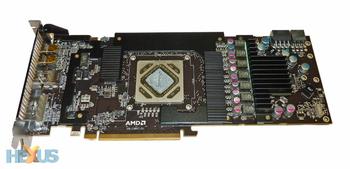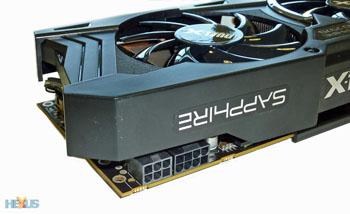Beating the reference model in every way
The GeForce GTX 680 is the best single-GPU graphics card available right now. This is what we said on the Kepler-based GPU's release late last week. AMD, however, reckoned we'd been premature in our praise of the green team's finest silicon. Hold on a second before making such asinine assumptions and leading readers astray, they intimated in a convoluted, roundabout way.
Fact of the matter is that while the GTX 680 is the best single-GPU graphics card we've tested, it doesn't obliterate AMD's Radeon HD 7970. The performance delta is, on average, 18 per cent at a 1,920x1,080 resolution, falling to 11.9 per cent at 2,560x1,600, according to our cumulative scores.
And AMD is keen to remind the press that the HD 7970 overclocks very nicely. One simply needs to look at a well-engineered, highly-overclocked HD 7970 and, perhaps, the choice isn't as straightforward as NVIDIA would have you believe. Championer of all things AMD, Sapphire Technologies snuck a new HD 7970 in the post. Say hola to the Radeon HD 7970 OC Dual-X, emboldened with plenty of frequency bite and a fancy-pants cooler.
Sapphire's aim with the Dual-X model is to bring it to market quickly. Price, too, is very in mind, insofar as any £400-plus graphics card can be considered cost effective. The PCB is absolutely reference, therefore mirroring what's on offer from the AMD-supplied card, but the cooling apparatus certainly isn't. Sapphire plonks a dual-fan solution on top of five heatpipes that are strategically located inside a 230mm-long heatsink chock-full of aluminium fins.
This type of cooling has been adopted by Sapphire for the previously-reviewed HD 7950 OC cards, though the fan-section looks even meatier than before. And just like that card, the plastic shroud incorporates two 90mm, PWM-controlled fans that stick out by around 15mm above the double-height backplate.
Take away the cooler and Sapphire's upgrades come into view. A frame sits on top of the 12 memory modules dispersed around the GPU. There is also dedicated cooling for the (very) hot-running power-regulation components on the right-hand side.
An inspection of the chunky heatsink reinforces our notion that it is, for all intents and purposes, the same as found on the HD 7950 mentioned previously. This is no bad thing, because that cooler is damn good.
Look, the cooler's back! The arrangement of the PCIe connectors is one method of discerning between the two best AMD HD 7900-series cards. Full-architecture HD 7970 ships with an 8+6-pin setup, as shown on the left, yet the GPU isn't particularly power-thirsty. We reckon a high-quality 500W is more than ample when the card is sat inside an Intel Sandy Bridge system.
Take a peek to the right and the tiny BIOS-flicking switch comes into view. Sapphire puts this to good use by loading two separate BIOSes. The first, which is the shipping default, increases the stock HD 7970's 925/5,500MHz speeds to 950/5,700MHz - a reasonable, if not outstanding, increase. Push the switch across and the OC frequencies rise further, to 1,000MHz/5,800MHz. Going hand-in-hand with the increase, the second BIOS also loads a more-aggressive fan-speed profile and enables a higher GPU voltage to be set.
Coming back to the card itself, the various heatsinks and plates are all screwed through the PCB. The card feels rigid and suitably high-end.
Last but certainly not least, the reference nature of the PCB dictates that video outputs also follows AMD's default selection of dual-link DVI, HDMI and a pair of mini-DisplayPorts.
We'd not usually comment on the bundle, for they tend to be generic, but Sapphire goes the extra mile by including an HDMI-to-DVI dongle; a mini-DisplayPort-to-full-size-DP dongle; and a miniDP-to-DVI dongle. The upshot of this is that one can connect three screens easily enough by using miniDP (via DVI dongle), HDMI and DVI.
Sapphire reckons it is to be made available for a small premium over the regular card, at £440 or so, though the best price we've seen is closer to £470. Conveniently ignoring price for a moment, the OC Dual-X is AMD's best hope of eating into NVIDIA GTX 680's performance lead. Let's now see how it performs.










